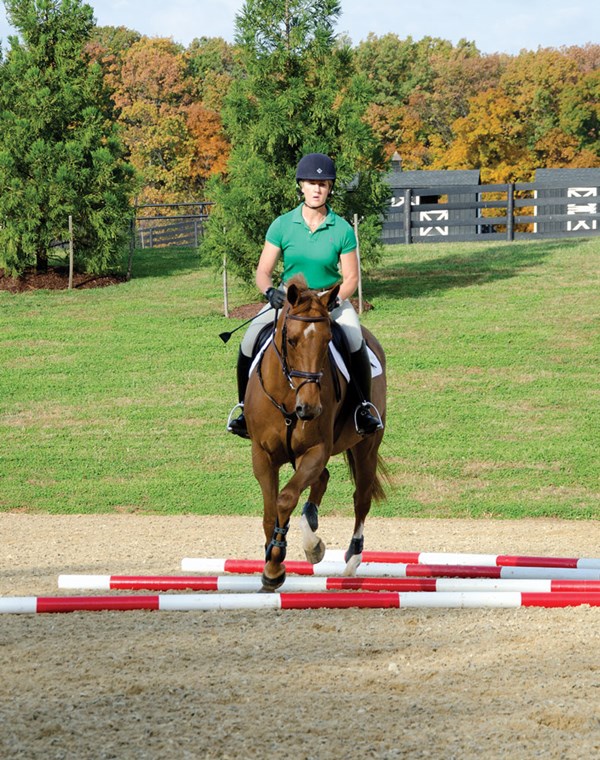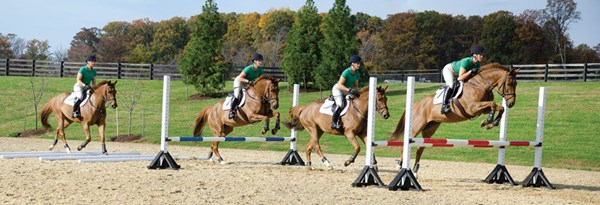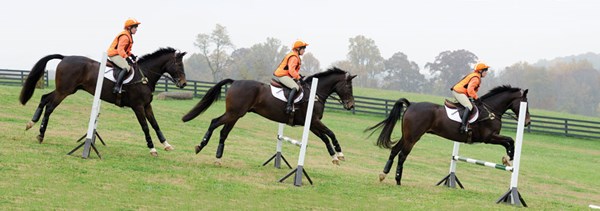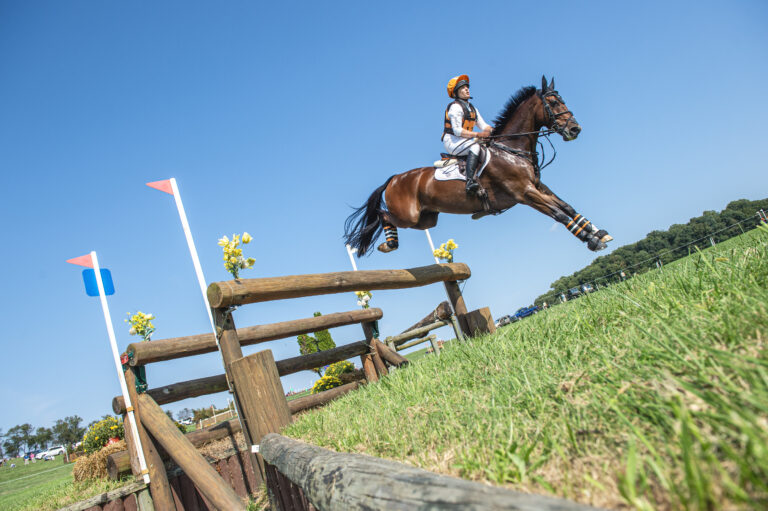 Gymnastics are limited only by the imagination of the trainer. Bert de Némethy, the U.S. Equestrian Team’s legendary show-jumping coach, once told me that when he designed cavalletti or gymnastics, he was taking responsibility for the placement of the horse’s step or stride. The curved cavalletti pattern you see here teaches horses to maintain the regularity of their step even when their body is curved. Because the distance between each rail changes from 3 feet on the inside to 6 feet on the outside, Allison Springer has been careful to aim Sophia at exactly the correct place on the first cavalletti so that Sophia has room for one step at her normal working trot between each cavalletti. You can see from Sophia’s bending that Allison’s aids are classically correct. | © Stacey Nedrow-Wigmore
Gymnastics are limited only by the imagination of the trainer. Bert de Némethy, the U.S. Equestrian Team’s legendary show-jumping coach, once told me that when he designed cavalletti or gymnastics, he was taking responsibility for the placement of the horse’s step or stride. The curved cavalletti pattern you see here teaches horses to maintain the regularity of their step even when their body is curved. Because the distance between each rail changes from 3 feet on the inside to 6 feet on the outside, Allison Springer has been careful to aim Sophia at exactly the correct place on the first cavalletti so that Sophia has room for one step at her normal working trot between each cavalletti. You can see from Sophia’s bending that Allison’s aids are classically correct. | © Stacey Nedrow-WigmoreSometimes my clinics are more fun for me than they are for the participants, especially during the question-and- answer sessions. I like to have Q&A at my clinics and seminars whenever possible because that means I am talking about something that interests at least one other person in the room. It’s better than delivering the same stale, canned lecture I gave last week (and the week before)—and the questions keep me up to date on issues that are currently hot topics for the general membership. Most of the time, I have been asked the question before and have a response. (I wrote a column on the most common clinic questions a few years ago. You can find it at PracticalHorsemanMag.com.)
I get a question every now and then, however, that makes me stop and think. At a recent clinic, I was discussing the gymnastic exercises I planned to use that day when a young lady held her hand up and asked, “Jim, OK, my horse is a good jumper and we can do these exercises for sure, but why do you use gymnastics in the first place?”
I have heard variations of this question before and gave my short version of the answer: Gymnastics, by which I mean placing any two or more obstacles a certain measured distance apart, help both your horse and you to jump better. They improve your horse’s footwork, technique and confidence. At the same time, you get a chance to learn through repetition, to jump in a predictable fashion and to think about one particular part of your jumping motion at a time. For example, how do your ankles feel when you land or how do your elbows follow your horse’s mouth in the air?
Although these reasons are all valid, it struck me later that gymnastics are a much wider and deeper subject than my short response suggests and that we ought to talk about my answers in greater detail than I can when under the time pressure of a clinic.
 The next time you jump some gymnastics, I want you to keep this sequence in your mind because this is what I am looking for—calm, straight, poised, balanced and attentive. One of many advantages of gymnastic work is that you already know the correct answer. Each time you take a step or a stride, your mind should already be planning to execute the next part of the gymnastic. When the rider jumps a gymnastic line, her head should remain at the same level throughout the exercise and her seat should come out of the saddle the same amount that she would show during the rising part of her posting-trot motion. When Allison and Sophia jumped this line, you can see why I said, “Come again, Allison. Stay a little closer to the saddle and lower your hands at the top of the bascule.” The next time you see Allison, you will notice the results of her hard work over exercises such as this one. | © Stacey Nedrow-Wigmore
The next time you jump some gymnastics, I want you to keep this sequence in your mind because this is what I am looking for—calm, straight, poised, balanced and attentive. One of many advantages of gymnastic work is that you already know the correct answer. Each time you take a step or a stride, your mind should already be planning to execute the next part of the gymnastic. When the rider jumps a gymnastic line, her head should remain at the same level throughout the exercise and her seat should come out of the saddle the same amount that she would show during the rising part of her posting-trot motion. When Allison and Sophia jumped this line, you can see why I said, “Come again, Allison. Stay a little closer to the saddle and lower your hands at the top of the bascule.” The next time you see Allison, you will notice the results of her hard work over exercises such as this one. | © Stacey Nedrow-WigmoreCarefully Measure Distances
One characteristic of gymnastic jumping is that the distances used are very carefully measured. When you set up your exercises, don’t rely on the accuracy of your step; use a tape measure. The reason: The distance you are using is designed to produce a certain effect on your horse’s stride so that you can concentrate on that effect when riding the gymnastic. For example, I use a placing rail 9 feet before the obstacle at the start of my gymnastics. This rail does exactly what its name says—it places your horse’s feet for the correct takeoff point over the first obstacle. If this rail is too close or too far away from the obstacle, you will get incorrect jumping until you measure the distance exactly and put the rail in the correct spot. There are enough variables involved in training horses without introducing one variable that we could otherwise control.
Predictability
I think one of the main reasons that horses and riders like (and benefit from) gymnastic jumping so much is that their activity becomes predictable. When you trot into a gymnastic, you should already know the desired outcome. You can devote your time to riding in a predetermined rhythm rather than thinking, “Boy, I hope this works.” Because you and your horse move in a rhythm, you will both relax and your confidence will improve.
Relaxation is important for several reasons. When your horse relaxes, teaching him to jump in good form is easier. Most horses jump well—meaning they use their legs correctly—when they are at liberty. It is only when we place our weight on their backs and interfere with their mouths that they have problems. Gymnastic jumping teaches your horse to jump just as well with your weight on his back as he does at liberty. In order to achieve this, the majority of your early gymnastic lessons with me will be on a long or loose rein. I want you to learn to be an intelligent passenger, and I want your horse to become intelligent and independent of your actions. Only after you are secure in your saddle without pulling on your horse’s mouth and your horse is capable of maintaining his speed and rhythm without help from you, then, and only then, are you ready for more sophisticated work over fences.
 Gymnastics do not have to take place on level ground. They can have the same beneficial effect on cross-country horses and riders as gymnastic work done in an arena. Sharon White is introducing Don Sheffield (Shu) to downhill bounces. Shu had already been introduced to the concept of both single and double bounces on level ground, so this exercise is the logical next step in his educational progression. We can tell that Shu is green but willing—he lands a bit short after the first rail. Sharon is fixing this by closing her lower leg as he lands. With the slightest encouragement, Shu is far more confident about the second and third rails. This exercise is built on an incline that has some slope to it, but it is not yet what I would call steep and can be jumped in both directions. The rails start out quite low, considering that Shu is a Preliminary horse, but I never get in trouble by making the jump too low at first. Once my horse understands the concept, I can raise the rails. | © Stacey Nedrow-Wigmore
Gymnastics do not have to take place on level ground. They can have the same beneficial effect on cross-country horses and riders as gymnastic work done in an arena. Sharon White is introducing Don Sheffield (Shu) to downhill bounces. Shu had already been introduced to the concept of both single and double bounces on level ground, so this exercise is the logical next step in his educational progression. We can tell that Shu is green but willing—he lands a bit short after the first rail. Sharon is fixing this by closing her lower leg as he lands. With the slightest encouragement, Shu is far more confident about the second and third rails. This exercise is built on an incline that has some slope to it, but it is not yet what I would call steep and can be jumped in both directions. The rails start out quite low, considering that Shu is a Preliminary horse, but I never get in trouble by making the jump too low at first. Once my horse understands the concept, I can raise the rails. | © Stacey Nedrow-WigmoreTraining Scale Similarities
Before I go on, make a mental note of the similarity of this process to the dressage Training Scale: rhythm, relaxation, contact, impulsion, straightness and collection. As soon as you move in a rhythm, you will start to relax. Once you are relaxed and stable in the saddle while jumping, I will introduce contact to you and your horse. But I will not introduce you and your horse to the use of contact over fences until your position is very stable and your horse has learned self-carriage and initiative on his own. Once the two of you are both self-confident, I will then introduce you to the use of contact when jumping.
After practice, you and your horse will become comfortable jumping with a connection between your hand and his mouth. Still using gymnastics, I will then introduce you to controlling your horse’s impulsion by lengthening and shortening his stride. It is hard for me to talk about jumping without talking about dressage. You should notice the order in which I talk about changing your horse’s stride: We go forward first, then we collect. This is as true of jumping as it is of dressage.
At this point, I will introduce gymnastics that teach you and your horse to deal with straightness, which is another way of saying that we have to make sure you and your horse can jump angles, narrows, corners and so on.
Just as with dressage, collection is the last thing we introduce to our horses.
Collection while jumping, Jim? Really?
Yes, really. Let’s talk about it by, as usual, talking about dressage first. If I get on a 4-year-old Thoroughbred fresh off the track, sit upright, squeeze with my heels and maintain the contact with my reins, what will happen? You got it; I will be off like a rocket. My “green bean” will lean on the contact, transfer his weight to his forehand and increase his speed. That response isn’t what I want but is what I will get. Now, let’s revisit the same horse four years later and see what correct training can do. After I warm him up and then apply the same aids as before, the horse will respond to my aids by rounding his step and increasing his energy without changing his rhythm or balance.
OK, that is a crude description of dressage collection, so what about jumping collection?
Let’s take the same green 4-year-old Thoroughbred and see what happens to his jumping when I take a contact in the air over a fence. He will invert his back in the air and land going faster than when he took off, much the same response he gave when I took a contact on the flat. However, after four years of correct jumper training, if I take a stronger contact in the air, he will round his back and land with a collected stride. Given the interconnected nature of modern show-jumping courses, the advantages of this are obvious.
Throughout this column, I have been talking about using gymnastics to improve your horse’s jumping. However, you should realize that gymnastic jumping can be a valuable tool for dressage horses as well. A day of gymnastic jumping can keep your dressage horse from becoming bored. It can also help you supple your horse. For example, if he is stiff on his left side (which means his muscles are short on the right side), you can canter a circle to the left over small—2 feet or less—obstacles. After a few repetitions, he will start to land on his inside lead, lower his head and neck in the air and stretch his body as he jumps. Gymnastic jumping is a valuable tool for almost every horse.
Purchase a copy of Jim’s book, Modern Gymnastics: Systematic Training for Jumping Horses at www.equinenetworkstore.com.
This article originally appeared in the February 2016 issue of Practical Horseman.
Save










